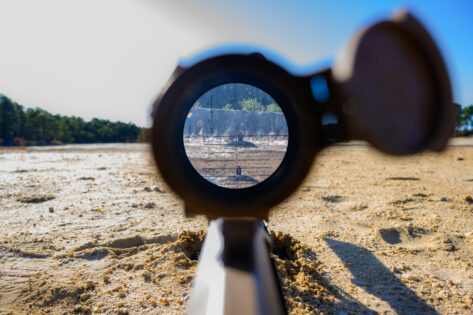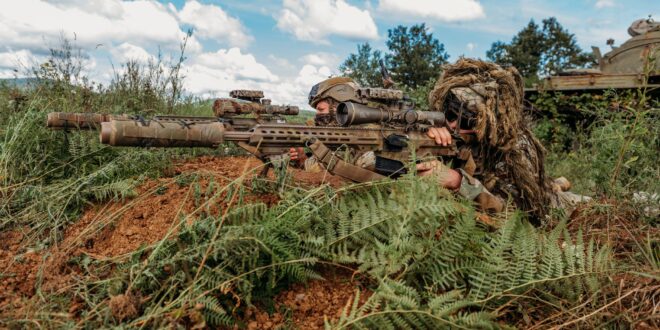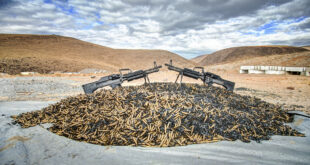by Austin Lee
Recent reports of unintended discharges with the MK22 sniper rifle have sent uneasy shockwaves through the military community. Videos are circulating on social media depicting the rifle firing prematurely. This trend demands swift attention, given the MK22’s critical role in high-stakes operations.
The Barrett MK22, designated as the Precision Sniper Rifle (PSR) by the U.S. Army, represents what the pinnacle of modern sniper technology should look like. Born from the Barrett Multi-Role Adaptive Design (MRAD) platform, the MK22 is a bolt-action rifle engineered for versatility and lethal accuracy across multiple calibers – 7.62x51mm NATO, .300 Norma Magnum, and .338 Norma Magnum. Its modular design allows for rapid caliber conversion, adapting to what each mission demands. Fielded by multiple elite military units, this rifle has arrived at the forefront of many long-range engagements.
READ MORE from Austin Lee: The MAC JSOC 1911: A Modern Salute to a Special Operations Legacy
The MK22 is a testament to engineering prowess, with a length of 49.4 inches (125.5 cm) when configured for .338 Norma Magnum, and a weight of approximately 14.8 pounds (6.7 kg) without optics. Its 24.5-inch (62 cm) barrel, coupled with a Leupold Mark 5HD 5-25x56mm optic, ensures sub-MOA (Minute of Angle) performance, capable of grouping shots within 0.45 MOA on average, with exceptional shooters achieving 0.31 MOA.
The rifle’s patented quick-change barrel system features a tool-less design that allows for quick seamless transitions between calibers, a distinctive advantage in diverse operational environments. Its folding stock and adjustable cheek piece enhance ergonomics, while the match-grade trigger provides a crisp, 4.5-pound pull, which should give the shooter confidence in high-stakes scenarios.
The advantages of the MK22 are many. Its adaptability across calibers extends its effective range from 800 meters with 7.62x51mm to more than 1,500 meters with .338 Norma Magnum, making it a versatile weapon for both counter-sniper operations and precision strikes at distance. The rifle’s robust construction, machined from 7075-T6 aluminum and 4150 CMV steel, ensures rugged durability under extreme conditions, a necessity for special operations forces. Moreover, its integration into the U.S. military’s arsenal underscores its role as a force multiplier, enhancing the lethality and flexibility of sniper teams.
The MK22’s journey began in 2009 when the United States Special Operations Command (USSOCOM) issued a call for a new precision sniper rifle to replace aging rifle platforms. Barrett Firearms Manufacturing, leveraging its battle proven experience with the Barrett 98B, responded with the MRAD, a design that met SOCOM’s rigorous specifications for modularity, accuracy, and reliability.

A look through the sites of an MK-22 Precision Sniper Rifle (photo by Spc. Michael Schwenk)
In 2013, after extensive trials, the MRAD was selected as the winner of the PSR competition, though initial contracts were awarded to Remington for the Modular Sniper Rifle. By 2021, the U.S. Army awarded Barrett a $49.9 million contract for 2,800 MK22 rifles, recognizing the platform’s rising superiority. The Marine Corps followed with plans to procure 250 units, solidifying the MK22’s role across the Department of Defense.
Units fielding the MK22 include the Army’s 75th Ranger Regiment, Special Forces groups, and Marine Corps Scout Snipers, elite units that demand the highest standards from their equipment. These units have deployed the MK22 in theaters ranging from the arid deserts of the Middle East to the dense jungles of the Indo-Pacific, where its versatility has been proven invaluable.
Barrett Firearms Manufacturing, founded in 1982 by Ronnie Barrett, has long been synonymous with innovation in the long-range shooting industry. The company’s .50 BMG rifles, notably the M82 and M107, have been staples of military and law enforcement arsenals worldwide.
However, in a surprising turn, Barrett merged with NIOA, an Australian defense contractor, in 2023, marking a shift from an American to an Australian industrial corporate identity. This merger, while controversial among traditionalists, aims to expand Barrett’s global reach and integrate advanced manufacturing capabilities, potentially influencing future designs like the MK22 and beyond.
Questions keep being raised, though, within the gun community.
The recent reports of premature firing often occur when the bolt is not fully in battery or when the operator lightly taps the bolt handle with a hand nowhere near the trigger.
The root causes remain undetermined, but potential factors could include manufacturing issues, faulty ammunition, or improper maintenance techniques.
The weapon’s manual explains what to do if the rifle does not fire when it should.
“If your rifle fails to fire when you pull the trigger, do not lift the bolt handle to open the action,” the manual states. “Keep the rifle pointed toward a safe area and wait 2 minutes. If a hangfire (slow ignition) has occurred, the round will probably fire within two minutes.
“If the round does not fire, remove and inspect the cartridge. If the primer is indented properly, discard the cartridge in a safe manner. If the primer is lightly dented, refer to the troubleshooting chart in this manual.”
Due to the volume of videos displaying a variety of uncommanded discharges, this issue doesn’t appear to be solely related to defective ammunition. If reports are correct, this could point more to a mechanical issue.
“The rifle fires when you start moving the bolt,” one user wrote on social media. “That’s not a misfire. That’s not a bad primer,” Armchair Sniper posted on Instagram. “That’s a mechanical failure in the firing mechanism or bolt assembly that’s delaying firing pin release until the action moves.”
This translates into a serious problem, he noted.
“You’re flirting with an out-of-battery discharge.”
The longevity of the MK22 hinges on addressing these issues swiftly. Moreover, in an era where adversaries are rapidly advancing their own capabilities, the U.S. military cannot afford lapses in equipment reliability.
Questions about the MK22 come at a time when the U.S. military is facing scrutiny involving alleged uncommanded discharges with the SIG Sauer M18 pistol. The U.S. Air Force has ordered a safety inspection of its 125,000 M18’s, after a 21-year-old Airman died when his service pistol allegedly discharged uncommanded.
It is our hope that, in shedding some light on these issues, positive changes and fast-track remedies will be found, in order to solidify the sacred trust between our military forces and the tools they rely upon to do their jobs safely and efficiently.
A representative from Barrett did not immediately respond to a request for comment.
Austin Lee is the proprietor of Galilhub, and is a gunsmith and a competitive shooter. He writes frequently for Soldier of Fortune.

 Soldier of Fortune Magazine The Journal of Professional Adventurers
Soldier of Fortune Magazine The Journal of Professional Adventurers






